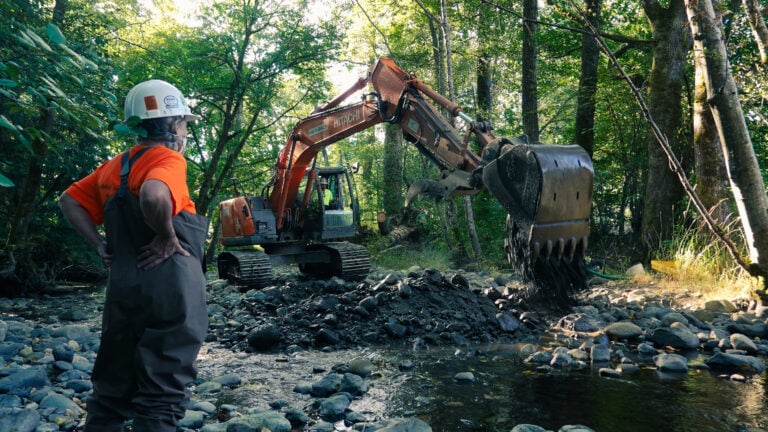
Environmental DNA, commonly called eDNA, is DNA that is shed from organisms in the natural environment. Skin cells, mucus, urine, and feces all contain the signature DNA of the animal that shed them. Everywhere animals go, they leave a trail of eDNA behind. As a result, using cutting-edge genetics techniques we can sample eDNA in streams to determine, with confidence, whether fish species of interest were present upstream from the sample site, or were there within the week preceding the sampling event.
This requires having DNA from the target species, against which the sampled eDNA is compared in a laboratory. The DNA ‘library’ from target species in the Pacific Northwest is growing rapidly as eDNA becomes more widely used by researchers to better understand the distribution of fishes.
Because the fieldwork simply requires filtering stream water, eDNA assessments are done without handling the target species – an important consideration when working with populations of threatened or endangered fish. It has revolutionized researchers’ ability to understand fish species distribution at the landscape-scale.
Understanding where threatened and endangered fish live is fundamental to efforts to effectively protect and restore the habitats they rely upon. This, along with hatchery and harvest reform, provides a recipe for recovery.


WEB MAP: View the Middle Fork Snoqualmie & Raging River Alluvial Water Storage Assessment Results

Wild Fish Conservancy worked with an environmental engineering firm to assess the feasibility of large wood (LWD) supplementation in the Snoqualmie River from its confluence with the Tolt River, downstream to Harris Creek near Chinook Bend Natural Area (River Mile 21-25). The assessment laid the foundation for conceptual designs that will detail instream LWD treatments in the Chinook Bend -Tolt reach of the Snoqualmie River. Public outreach was conducted to assess recreational boater usage in a 4-mile reach of the Snoqualmie River that is critical salmon habitat. The information gained from the public outreach was used to inform the design of conceptual Large Woody Debris (LWD) habitat restoration treatments in the reach.

This project identifed, prioritized, and provided preliminary designs to restore a unique Deschutes River spring fed wetland and stream
complex. Restoration actions identified include removing three failing culverts, livestock
exclusion fencing to protect streams and wetlands, instream LWD placement, and riparian restoration, along with a suite of farm management BMPs.


During this project WFC placed large wood within a half-mile reach of Grant Creek. The large wood complexes will encourage the development of new scour pools and to improve overall channel complexity.



Lorem ipsum dolor sit amet, consectetur adipiscing elit.
Join our mailing list to recieve important updates on our work, the latest wild fish news, & opportunities to take action to support wild fish.
This site is protected by reCAPTCHA and the Google Privacy Policy and Terms of Service apply.
Wild Fish Conservancy is recognized as a 501(c)3 non-profit by the IRS